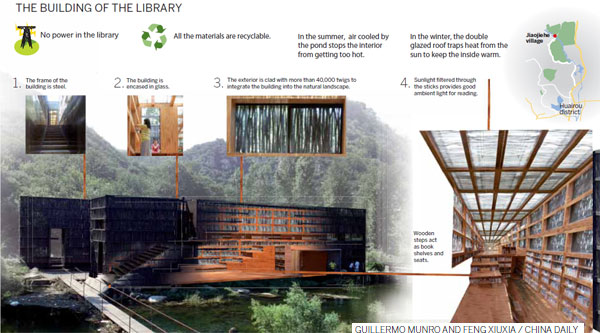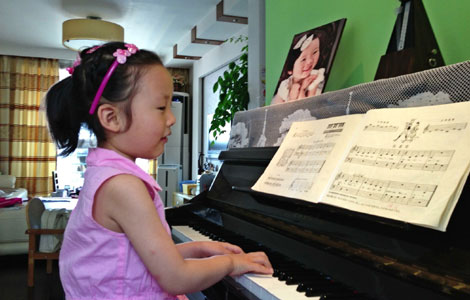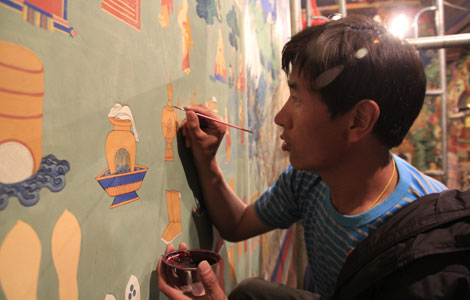Sticking up for sustainability
Updated: 2013-07-25 06:37
By Sun Yuanqing (China Daily)
|
||||||||



Liyuan Library integrates architecture into the natural landscape using traditional Chinese architectural concepts. Sun Yuanqing reports.
Rows of firewood are the first impression of Liyuan Library, which sits beside a pond surrounded by mountains in the Huairou district of Beijing. On a day when the tranquility is broken only by birdsong, it is "a setting for clear thoughts" as the building's designer describes it.
Designed by Chinese architect Li Xiao-dong, the library was one of the winning designs in the 2013 Architecture of Necessity competition held in Sweden in June, making it the first Chinese project to claim the honor.
"It is a contemporary project, but it is full of Chinese traditional wisdom," says Li, who is also a professor at Tsinghua University in Beijing. "I wanted to explore how to integrate architecture into the natural landscape using traditional Chinese architectural knowledge."
The intention was to make a modest complement to the beauty of the natural surroundings. "You can never compete with nature's splendor," Li says.
Li also wanted it to resonate with the local villagers. "With Liyuan, I also tried to test new ground by using local materials to address the issues of the local community, which is another important aspect of sustainability."
When Li strolled around the village for research, he found that one of the richest local resources was the wood the locals use for heating and cooking. He decided to use this ordinary material in an extraordinary way.
More than 40,000 sticks were cut to a uniform length and used to clad the exterior of a glazed shell. The multiple layers of sticks not only act as decoration, they also filter the daylight to create a nice ambience for reading. "From season to season, the color of the sticks will change with the mountain," Li says.
As there is no artificial coating, Li expects the sticks to house birds and other wildlife.
"The sticks came from nature and will eventually evolve into part of nature again. I want the building to have the least impact on the landscape, which echoes the Chinese philosophical idea that humans are part of nature."
Inside the building there is no traditional furniture, as the steps between levels also act as seats and shelves. "We've had this idea of a modular system in the Chinese tradition of architecture all the time," Li says.
On weekends, the place can be quite busy, as Beijingers come to escape the city. However, there are still quiet corners to be found for those who actually want to read a book.
"There are many distinct corners created by the small level changes, so I don't really have a problem finding a place to settle," says Zhang Jie, a college teacher who is visiting the library for a second time with her 5-year-old daughter.
The building is fully glazed to allow the largest amount of daylight to enter, as the library has no power supply, which means there is no heating or air conditioning.
To solve the problem, Li placed the entrance of the library on a lower level above the pond so that in summer the cool air above the water is sucked into the house.

Windows are placed at the levels where people sit to let the breeze pass through.
The roof of the building is also covered with the firewood, but the wood is sandwiched between two layers of glass so that heat will be trapped inside to warm the building during winter.
"Technology is not simply a tool, it is also a concept. It has to be integrated into the architectural space in a way that allows the house to ventilate itself according to the outside environment," Li says.
Special consideration was put into the visual effect of the building, which is 6.3 meters high. Any change in height would break the roof line, which Li believes would be disturbing not only to people's vision, but also to the landscape. "The simpler our design is, the easier it is to integrate it into the natural surroundings," he says.
Since its opening in November 2011, the library has received more than 7,000 books from the public. Visitors are invited to donate a minimum of three books and in return, they are allowed to take one book away, making the venue a platform for an exchange of ideas.
Originally intended to help the village, where there was no school or library, Li-yuan Library is now serving a bigger community. People living in the downtown drive for two hours to the library on weekends, and the villagers are benefiting by selling them food and hospitality.
"Before the library was built, we were worried that it might damage the originality of our village," says Wang Fuying, a villager who volunteers at the library. "Now we are relieved. The kids finally have a place to read. More visitors also mean more opportunities for small businesses."
And that's exactly what Li had hoped for, "to let architecture play a broader role in the nourishment of a community".
Contact the writer at sunyuanqing@chinadaily.com.cn.

(China Daily USA 07/25/2013 page8)

 Death toll in Spain train crash rises to 56
Death toll in Spain train crash rises to 56
 Royal baby named George Alexander Louis
Royal baby named George Alexander Louis
 'The Grandmaster' takes center stage
'The Grandmaster' takes center stage
 Fewer Chinese consumers picking Apple's iPhone
Fewer Chinese consumers picking Apple's iPhone
 Yuan: Financial capitals vying for top spot
Yuan: Financial capitals vying for top spot
 Little princes and princesses
Little princes and princesses
 Obama lauds Louisville in White House visit
Obama lauds Louisville in White House visit
 PLA special forces hold military contest
PLA special forces hold military contest
Most Viewed
Editor's Picks

|

|

|

|

|

|
Today's Top News
Bo indicted for bribery, corruption and power abuse
Snowden's hopes of leaving airport dashed
US extends review of Shuanghui, Smithfield merger
'Few hundred' at Manila anti-China rally
Obama, Congress both losing public support
Abe seeking to 'contain' Beijing
Li points way for railways reform
VP visits Pyongyang for 60th truce anniversary
US Weekly

|

|






